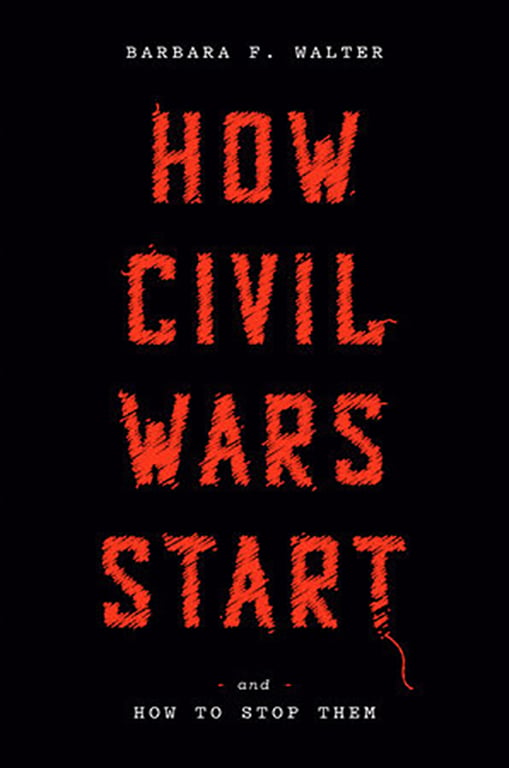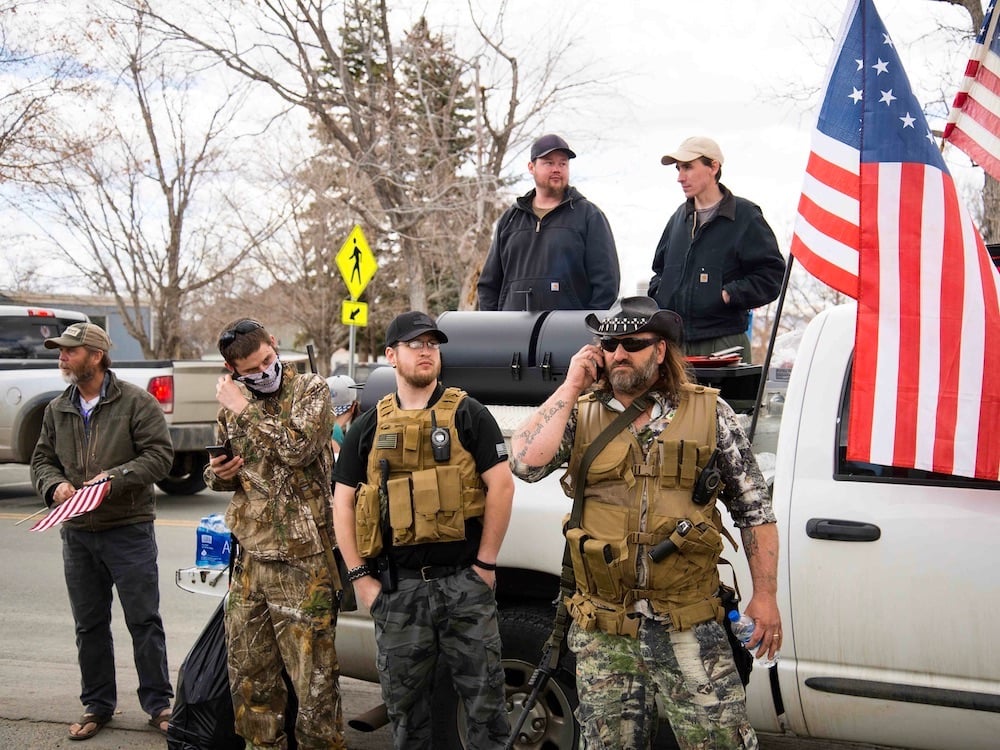- How Civil Wars Start: And How to Stop Them
- Crown (2022)
The Americans have been talking about a new civil war for years now, and a new book by a leading political scientist makes it sound all but inevitable. Barbara F. Walter’s analysis is grim for Americans and alarming for Canadians. We should start thinking now about how to respond.

Civil war speculation began with Donald Trump’s presidency, but didn’t really get going until the Capitol insurrection on Jan. 6, 2021. Since then, many researchers have been trying to find out if a second civil war is more than a subject for anxious pundits.
Some of those researchers have published on medRxiv, a preprint website normally dedicated to very recent research into COVID-19 and other diseases. But the other day it published a new study into another kind of health issue: the likelihood of Americans using violence against one another to achieve political goals.
The researchers at the University of California’s Davis campus found that over 40 per cent of those interviewed believed “having a strong leader for America is more important than having a democracy.” The same percentage agreed that “in America, native-born white people are being replaced by immigrants.”
About three-quarters of the 8,620 interviewees said violence is sometimes justified to achieve political objectives; of those, 12 per cent were willing to commit political violence “to threaten or intimidate a person.” Four per cent said they were willing to kill.
As alarming as it is, the UC Davis study only confirms what Barbara F. Walter argues in her new book: far from being exceptional, the U.S. is very much like other countries that suddenly topple into civil war.
Danger in the middle
Walter finds a number of key factors that can combine to trigger a civil war. But they don’t include revolts against outright tyranny (or against a functioning democracy). She argues that countries generally stand somewhere on a “polity index scale” between full democracy and all-out dictatorship. In the middle are “anocracies,” countries mingling both democratic and authoritarian traits.
She writes: “It turns out that one of the best predictors of whether a country will experience a civil war is whether it is moving toward or away from democracy.” In either case, some groups gain power while others lose it.
Walter cites the Americans’ inept attempts to democratize Iraq, which including disbanding the army and firing all the civil servants. Those groups tended to be Sunni Muslims, a minority in Iraq, and they were replaced by members of the Shia majority. It was more democratic, but the move caused serious instability.
“Rapid regime change,” Walter writes, “almost always precedes instability, and civil wars are more likely to break out in the first two years after reform is attempted.”
Democracies growing fewer
If democratization can cause civil wars, so can autocratization. Walter cites the V-Dem Institute, a Stockholm think tank, which in its latest report says: “Liberal democracies peaked in 2012 with 42 countries and are now down to the lowest levels in over 25 years — 34 nations home to only 13 per cent of the world population.” The report finds Canada well down the list of liberal democracies — but finds the U.S. even lower, with “substantial autocratization” in the past 10 years.
Ethnic factionalism, Walter says, is another major driver, responsible for 75 per cent of the civil wars fought since the end of the Cold War. The key issue is whether ethnic or religious groups hold power or share it. Yugoslavia under Josip Broz Tito involved ethnic power-sharing (and a repressive state). As the country edged toward democracy after Tito’s death; Serbs, Croats and other ethnic factions began to grab as much power as they could. The result was a savage conflict that shocked the world.
Civil war is still more likely if a faction grows into a “superfaction” with the same ethnicity or race, the same religion and class, and the same geographical location. The faction is likely mostly rural or mostly urban. This is full-blown identity politics, and members of a superfaction have nowhere else to go unless they can leave the country.
Entrepreneurs of ethnicity and violence
Essential to factionalism are the leaders Walter call “ethnic entrepreneurs,” who persuade their followers that some “outside” group threatens them. If the followers begin to arm themselves in self-defence, the outsiders feel forced to do the same. Then the “violence entrepreneurs” step in, including the “outbidders” — groups that go to an extreme of violence to control their faction and intimidate enemies and allies alike.
Surprisingly, income inequality doesn’t start civil wars.
“People may tolerate years of poverty, unemployment and discrimination,” Walter writes. “They may accept shoddy schools, poor hospitals and neglected infrastructure. But there is one thing they will not tolerate: losing status in a place they believe is theirs. In the 21st century, the most dangerous factions are once-dominant groups facing decline.”
Climate disasters, on the other hand, can intensify the suffering of poor and rural groups, who see themselves victimized and further impoverished by urban-elite governments. The Syrian civil war began with a serious drought, driving farming communities into the cities in search of work.
One more factor is critical, Walter explains: “Scholars know where civil wars tend to break out and who tends to start them: downgraded groups in anocracies dominated by ethnic factions. But what triggers them? What finally tips a country into conflict? Citizens can absorb a lot of pain. They will accept years of discrimination and poverty and remain quiet, enduring the ache of slow decline. What they can’t take is the loss of hope.”
Walter’s analysis of the causes of civil wars is more persuasive than her suggestions for preventing them. She finds social media a major force in modern civil wars, exploiting ethnic and social divisions, but doesn’t offer a plausible way to control them. She criticizes the quality of American elections, notorious for gerrymandering and voter restriction, but it’s not clear how elections could be cleaned up — or how voters would believe it if they were.
Hard to prevent a civil war
“The best way to neutralize a budding insurgency is to reform a degraded government: bolster the rule of law, give all citizens equal access to the vote and improve the quality of government services,” Walter argues.
That would be a challenge in a country like the U.S., where people are taught to believe that government is the problem.
Walter thinks grassroots reform at the local level would enable Americans “to shore up our democracy, stay out of the anocracy zone and rein in social media, which will help rein in factionalism. This will give us a chance to avoid a second civil war.”
At this point, however, grassroots organizations are mostly on the far right, dedicated to taking over school boards, forcing public health officials to resign and banning books.
But who, actually, would launch the Second American Civil War? Both left and right feel degraded: Make America Great Again clearly implies it isn’t at present, while Democrats invoke all the laws and institutions degraded after Trump became president. Walter offers us a scenario in which a number of state legislatures are simultaneously bombed, with a right-wing militia group the likely perpetrator.
The leaderless resistance
That suggests a great deal of co-ordination, planning and funding, and perhaps it could happen. Whatever the outcome, it wouldn’t be a clash of armies — it would be a battle between a government and a “leaderless resistance” in which small groups imitate and outdo one another in domestic terrorism.
A right-wing resistance would be extremely ugly. Those defined as “left-wingers” would be targeted for assassination. Schools and public libraries would be purged of unwelcome ideas and staff, and universities would soon follow. Government agencies would be bombed or simply ransacked. The left would go after prominent state officials and militia leaders. The U.S. would become a checkerboard of red and blue states, receiving refugees from one another and staging raids across state lines.
A Democratic president might be tempted to send in the regular army, but that would be a mistake: as Walter observes, nothing radicalizes a community like being attacked by government forces. More likely the Democrats would simply turn off the federal cash flow to Republican states and communities: no more funding for health care, education or infrastructure until the terrorists were identified and handed over. Federal military bases would shut down in red states, depriving local communities of economic support. Nuclear and other weapons would be discreetly transported to safety.
The global reaction to an American civil war would be like that of the collapse of the Soviet Union: shock, surprise, alarm and a bit of relief. But we in Canada would face some unique problems.
Whom should Canada support?
First of all, should we support a Republican government facing a left-wing resistance? Or Democrats fighting right-wing militias? Should we screen American refugees on political grounds? If so, which are acceptable? And what about the estimated 640,000 or more Canadian citizens living in the U.S.? How will we make room for them if they decide to return?
We’ve seen how easily a few trucks can blockade a border crossing; imagine such blockades imposed by resistance groups from Blaine, Washington to Calais, Maine — shutting down trade for days or weeks. Or the U.S. government might shut the border to punish us for some imagined offence. Even if the border stays open, both countries’ economies are likely to suffer.
Imagine, also, Canadians heading south to fight for one side or the other. We’ve allowed Canadians to fight in Ukraine, but do we want right-wing Canadians to gain experience they could apply when they returned? Or left-wingers, for that matter?
Deprived temporarily of our key ally, we would have to create a new relationship with NATO. Taxes would have to go up to pay for serious military spending, not to mention supporting refugees and other migrants. We might even have to revisit conscription as a way to fill out the ranks.
And all this would be going on simultaneously with climate disasters, disease outbreaks, famines and routine political upheaval around the world.
Out of sheer stress, we might be tempted to autocratize ourselves, voting in some demagogue who would promise to make Canada strong in a dangerous world. And as we slid from democracy to anocracy, the scene could be set for a Canadian civil war. ![]()
















Tyee Commenting Guidelines
Comments that violate guidelines risk being deleted, and violations may result in a temporary or permanent user ban. Maintain the spirit of good conversation to stay in the discussion.
*Please note The Tyee is not a forum for spreading misinformation about COVID-19, denying its existence or minimizing its risk to public health.
Do:
Do not: